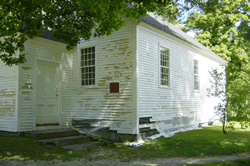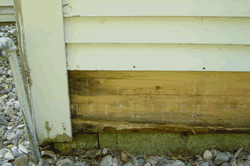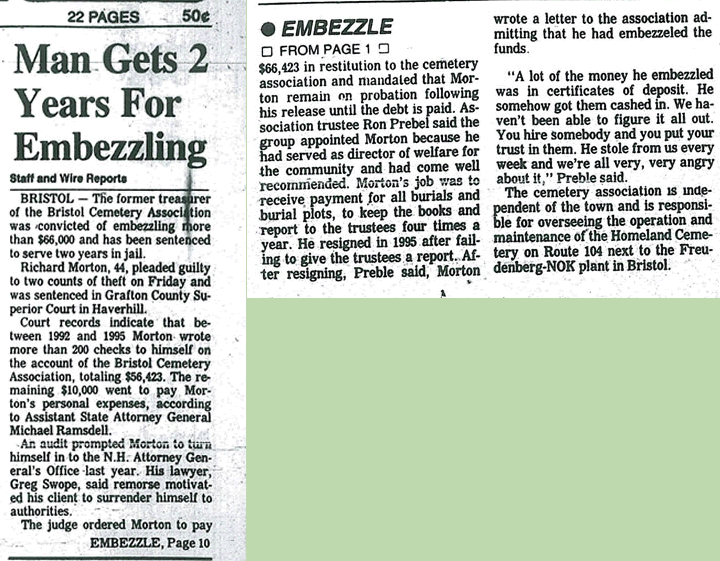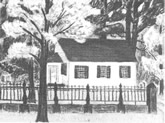Over the years the church building has suffered from neglect, which in many respects has been benign. Unfortunately, considerable damage has recently been done by well-intentioned but uninformed (or misinformed) attempts to repair the building.
Dr. James Garvin, NH State Architectural Historian, David Ruell (whose efforts were responsible for placing the church building on the National Register of Historic Places), and Marc A. Williams, President and CEO of the American Conservation Consortium http://www. conservator.com/ have provided a wealth of information and guidance for preservation of the building. Although it has long been available to the trustees, it has, unfortunately, been disregarded.
Dear Barry,
 I appreciated your notice of an opportunity to observe some new disclosures at Trinity Church. I took a look at the building yesterday. I’m attaching some photographs that show things that we could only have guessed at when we inspected the building some four years ago.
I appreciated your notice of an opportunity to observe some new disclosures at Trinity Church. I took a look at the building yesterday. I’m attaching some photographs that show things that we could only have guessed at when we inspected the building some four years ago.
First, there has been considerable deterioration of the sill of the main building adjacent to the entrance steps on the western end. This loss can be attributed to splashback of roof water from the granite steps onto the lower walls on the main building, followed by infestations of carpenter ants, powder post beetles, or both. As you will see from the first two attached photographs, at least half of the outer portion of the sill has been lost, leaving some of the wall studs unsupported from below.
main building, followed by infestations of carpenter ants, powder post beetles, or both. As you will see from the first two attached photographs, at least half of the outer portion of the sill has been lost, leaving some of the wall studs unsupported from below.
Second, the lower zones (at least) of clapboards on the south and west ends of the building were underlain with tarred felt. We can’t know how high this felt extends on the walls, but its presence under the newer clapboards in the lower area explains some of the excessively high moisture reading we detected four years ago. Application of clapboards over an impervious membrane like tarred felt is dangerous, especially in cases (as here) where roof water from the eaves will splash back onto the lower walls of the building. The tarred felt prevents the water from dissipating in the normal way, leading to high moisture content and dry rot. A better underlayment for new clapboards is rosin-sized building paper, a traditional wind-stopping membrane for use under clapboards.
four years ago. Application of clapboards over an impervious membrane like tarred felt is dangerous, especially in cases (as here) where roof water from the eaves will splash back onto the lower walls of the building. The tarred felt prevents the water from dissipating in the normal way, leading to high moisture content and dry rot. A better underlayment for new clapboards is rosin-sized building paper, a traditional wind-stopping membrane for use under clapboards.
The presence of this tarred felt has encouraged insect activity, and some decay, in the original sheathing boards (photo). You can see some frass (“sawdust”) from such activity in the fourth attached photograph. Luckily, this has not been catastrophic, and the original sheathing boards have survived rather well even in this lower zone.
 Third, we can see that the lower sheathing boards near the northeast corner of the building, near the water faucet, have been replaced by new sheathing (photo). Interestingly, there is no sign of tarred felt between this sheathing and the new clapboards, suggesting that the clapboard replacement on the south took place at a different time (and by a different carpenter) than that on the north.
Third, we can see that the lower sheathing boards near the northeast corner of the building, near the water faucet, have been replaced by new sheathing (photo). Interestingly, there is no sign of tarred felt between this sheathing and the new clapboards, suggesting that the clapboard replacement on the south took place at a different time (and by a different carpenter) than that on the north.
Finally, like you, I could see no sign that anyone has tried to lay a vapor barrier under the building. I couldn’t see much with my flashlight on a bright, sunny day, but there may be stone piers or other obstructions that may have discouraged any attempt, together with the very low depth of the crawl space.
with my flashlight on a bright, sunny day, but there may be stone piers or other obstructions that may have discouraged any attempt, together with the very low depth of the crawl space.
Replacement of the lower clapboards in damaged areas on the north and south walls will exclude water to a greater degree than has been the case when clapboards in these areas were in failing condition, but the building will continue to suffer from condensation beneath the floor under certain weather conditions.
The current work will certainly tighten the lower wall zones of the building for a few years, but other chronic threats will remain. It will be interesting to see what is done about the lost cross-section of sill at the southwest corner, adjacent to the granite steps.
Thank you again for giving me the chance to see the building under these circumstances.
Jim
James L. Garvin
State Architectural Historian
New Hampshire Division of Historical Resources
19 Pillsbury Street--2nd Floor
Concord, NH 03301-3570
Tel.: 603-271-6436
E-mail: james.garvin@dcr.nh.gov
Could It Happen Here?

Just across the river in Bristol, NH, Richard Morton, the treasurer of the private cemetery, embezzled over $66,000 in cemetery funds. Most of the money was lost betting at the dog track. Fortunately, Morton was exposed by an audit before he emptied the treasury. After he was released from jail he died without making restitution. His depredation put the Homeland Cemetery in danger of being taken over by the town.
This is what can happen when there are no checks and balances. Could it happen here? What factors might contribute to a situation like this?
1. No audits by CPAs for many years increases concern when the treasurer abruptly resigns and leaves area.
2.. Annual Proprietor's meeting given minimal publicity and held at inconvenient times allowing trustees to re-elect each other year after year.
3. Access to investment performance restricted to a chosen few.
4. Grounds keeping expenses many times greater than all surrounding cemeteries.
==================================================
Cemetery Trustees Face Fund Dilemma
==================================================
New Hampshire Sunday News (Manchester, NH)-December 8, 1996
Author: CAROL CARTER Sunday News Correspondent
BRISTOL - About 6,800 shareholders in the Homeland Cemetery Association will be asked next month whether to maintain control of the town's largest cemetery or ask taxpayers to take it over.
The dilemma faced by this 130-year-old association was triggered when a former treasurer embezzled more than $60,000 in cemetery funds. Association President Skip Bowie said he doubts they will ever recoup the funds embezzled by former treasurer Richard Morton, who he said is disabled and has no assets. Morton pleaded guilty in a negotiated plea and is serving time in the county house of correction. Bowie said the money was taken in small amounts over a period of time and was allegedly used for gambling................................
After meeting with selectmen last week, the association decided to host a meeting with shareholders in early January. All lot owners have voting rights and are urged to attend the meeting, Bowie said.
Selectman Michael Bannon said the town isn't anxious to take over the operation but understands the association's dilemma. There are other cemeteries in Bristol, but Homeland is the largest, Bannon said.
Page: 1B
Index Terms: CAC
Record Number: 0F545125AFE75F24
Copyright 1996, 2002 Union Leader Corp.
 Trinity Churchyard Cemetery
Trinity Churchyard Cemetery Trinity Churchyard Cemetery
Trinity Churchyard Cemetery